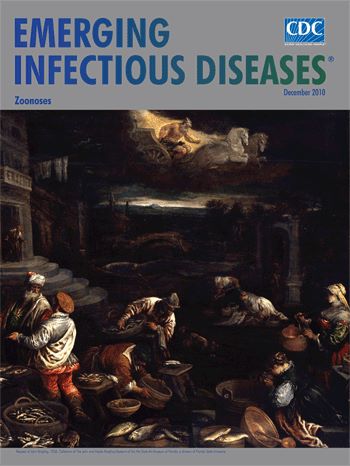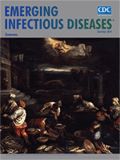
EID Journal Home > Volume 16, Number 12–December 2010
Volume 16, Number 12–December 2010
MEDSCAPE CME ACTIVITY
Pandemic (H1N1) 2009 Infection in Patients with Hematologic Malignancy
Medscape, LLC is pleased to provide online continuing medical education (CME) for this journal article, allowing clinicians the opportunity to earn CME credit. This activity has been planned and implemented in accordance with the Essential Areas and policies of the Accreditation Council for Continuing Medical Education through the joint sponsorship of Medscape, LLC and Emerging Infectious Diseases. Medscape, LLC is accredited by the ACCME to provide continuing medical education for physicians. Medscape, LLC designates this educational activity for a maximum of 0.5 AMA PRA Category 1 Credits™. Physicians should only claim credit commensurate with the extent of their participation in the activity. All other clinicians completing this activity will be issued a certificate of participation. To participate in this journal CME activity: (1) review the learning objectives and author disclosures; (2) study the education content; (3) take the post-test and/or complete the evaluation at www.medscapecme.com/journal/eid; (4) view/print certificate.
Learning Objectives
Upon completion of this activity, participants will be able to:
* Distinguish the most common presenting symptom of pandemic (H1N1) 2009 infection in the current study
* Analyze the course of lower respiratory tract infection with pandemic (H1N1) 2009 among patients with hematologic malignancy
* Develop appropriate management strategies for pandemic (H1N1) 2009 infection for patients with hematologic malignancy
Medscape CME Editor
Karen L. Foster, MA, Technical Writer-Editor, Emerging Infectious Diseases. Disclosure: Karen L. Foster, MA, has disclosed no relevant financial relationships.
Medscape CME Author
Charles P. Vega, MD, Associate Professor; Residency Director, Department of Family Medicine, University of California, Irvine. Disclosure: Charles P. Vega, MD, has disclosed no relevant financial relationships.
Authors
Disclosures: Catherine Liu, MD; Brian S. Schwartz, MD; Snigdha Vallabhaneni, MD; Michael Nixon, NP; Peter V. Chin-Hong, MD Steven A. Miller, MD, PhD; and W. Lawrence Drew, MD, PhD, have disclosed no relevant financial relationships. Charles Chiu, MD, PhD, has disclosed the following relevant financial relationship: served as a speaker or a member of a speakers bureau for Cubist Pharmaceuticals, Inc. Lloyd Damon, MD, has disclosed the following relevant financial relationships: served as a speaker or a member of a speakers bureau for Celgene Corporation; Eisai Inc.; owns stock, stock options, or bonds from Genentech, Inc.
Click here to continue to article:
Pandemic (H1N1) 2009 and Hematologic Malignancy, CME Activity | CDC EID

EID Journal Home > Volume 16, Number 12–December 2010
Volume 16, Number 12–December 2010
Research
Pandemic (H1N1) 2009 Infection in Patients with Hematologic Malignancy
Catherine Liu, Comments to Author Brian S. Schwartz, Snigdha Vallabhaneni, Michael Nixon, Peter V. Chin-Hong, Steven A. Miller, Charles Chiu, Lloyd Damon, and W. Lawrence Drew
Author affiliation: University of California, San Francisco, California, USA
Suggested citation for this article
Abstract
To assess outcomes of patients with hematologic malignancy and pandemic (H1N1) 2009 infection, we reviewed cases during June–December 2009 at the University of California San Francisco Medical Center. Seventeen (63%) and 10 (37%) patients had upper respiratory tract infection (URTI) and lower respiratory tract infection (LRTI), respectively. Cough (85%) and fever (70%) were the most common signs; 19% of patients had nausea, vomiting, or diarrhea. Sixty-five percent of URTI patients were outpatients; 35% recovered without antiviral therapy. All LRTI patients were hospitalized; half required intensive care unit admission. Complications included acute respiratory distress syndrome, pneumomediastinum, myocarditis, and development of oseltamivir-resistant virus; 3 patients died. Of the 3 patients with nosocomial pandemic (H1N1) 2009, 2 died. Pandemic (H1N1) 2009 may cause serious illness in patients with hematologic malignancy, primarily those with LRTI. Rigorous infection control, improved techniques for diagnosing respiratory disease, and early antiviral therapy can prevent nosocomial transmission and optimize patient care.
Influenza is a major cause of illness and death in patients with hematologic malignancy and in hematopoietic cell transplant (HCT) recipients. In up to 30% of HCT recipients, illness progressed to lower respiratory tract infection (LRTI); death rates were 28% for patients in whom pneumonia developed (1). During spring 2009, infection caused by pandemic (H1N1) 2009 virus emerged in Mexico and spread rapidly throughout the world (2–4). Although it does not appear to be associated with higher death rates than seasonal influenza (5), pandemic (H1N1) 2009 virus has caused severe disease and death, particularly in persons with preexisting illnesses (6,7). Little is known about the clinical features and outcomes of pandemic (H1N1) 2009 infection in patients with hematologic malignancy. One recently published study suggested that pandemic (H1N1) 2009 causes mild disease in most patients with hematologic malignancy (8), but several reports have been published about patients with severe infection and respiratory failure (9–11). Risk factors for progression to LRTI are unknown. To characterize the clinical spectra and outcomes of pandemic (H1N1) 2009 disease in patients with hematologic malignancy, we reviewed the first 27 cases of pandemic (H1N1) 2009 among these patients in the University of California San Francisco Medical Center during June 1–December 31, 2009.
Methods
Patients and Setting
The University of California San Francisco (UCSF) Medical Center (San Francisco, CA, USA) is a large, academic medical center with an active HCT program for children and adults and extensive experience treating children and adults with hematologic malignancy. In 2009, HCTs were performed for 171 adults and 50 children; a total of 1,020 adults and 782 children were admitted to the hospital's hematology/HCT service.
At UCSF, all nasal swabs performed to diagnose respiratory viral infection in inpatients and outpatients are routinely submitted for testing to the UCSF Virology Laboratory. For infection control surveillance during the pandemic (H1N1) 2009 outbreak, the UCSF Virology Laboratory generated a list of all laboratory-confirmed cases of influenza A during June–December 2009. HCT recipients and other patients with hematologic malignancy were identified through a retrospective chart review of all laboratory-confirmed cases of influenza A during this period. We used a standardized form to capture demographic data, clinical signs and symptoms, underlying hematologic disease and other medical conditions, transplant history, immunosuppressive medications, selected laboratory tests, radiographic findings, treatment course, and clinical outcomes. Dosing and duration of antiviral treatment with oseltamivir or zanamivir, use of concomitant antimicrobial therapy, and intravenous immunoglobulin was determined by the treating providers. The study protocol was approved by the UCSF Committee on Human Research.
Laboratory Confirmation of Infection
All diagnostic testing, including repeat serial testing, was performed at the discretion of the treating provider. The standard clinical practice for detecting respiratory viral infection, including influenza, was to obtain a nasopharyngeal wash, aspirate, or flocked swab for viral direct fluorescent antibody (DFA) testing (D3-DFA Respiratory Virus Screening and ID Kit, Diagnostics Hybrids, Athens, OH, USA) with same-day turnaround. Specimens from high-risk immunocompromised patients were submitted for multiplex PCR testing (xTAG RVP [Respiratory Viral Panel]; Luminex, Austin, TX, USA) if DFA results were negative. Results were considered consistent with pandemic (H1N1) 2009 infection when specimens were positive for influenza A by DFA or positive for influenza A matrix gene but negative for H1 and H3 hemagglutin gene subtypes by RVP. Pandemic (H1N1) 2009 infection was confirmed by using banked frozen specimens with at least 1 of 3 PCRs; the Xpert Flu A Panel (Cepheid Corp, Sunnyvale, CA, USA), the Centers for Disease Control and Prevention (CDC) real-time reverse transcription–PCR (rRT-PCR) swine influenza panel (performed at the San Francisco Department of Public Health), or a previously described PCR specific for pandemic (H1N1) 2009 performed in our laboratory (12). Patients were considered to have probable pandemic (H1N1) 2009 if laboratory-confirmed influenza A was detected during June–December 2009 and additional specimens were not available for confirmatory testing. CDC performed pyrosequencing to detect the H275Y mutation in the N1 neuraminidase gene associated with oseltamivir resistance.
Definitions
Upper respiratory tract infection (URTI) was defined as pandemic (H1N1) 2009 virus in nasopharyngeal specimen and compatible clinical symptoms without new pulmonary infiltrates on chest radiograph. Lower respiratory tract infection (LRTI) was defined as pandemic (H1N1) 2009 virus in a nasopharyngeal, endotracheal tube, or bronchoalveolar lavage specimen and compatible clinical symptoms with a new pulmonary infiltrate on chest radiograph or computed tomography (CT) imaging.
full-text (large):
Pandemic (H1N1) 2009 and Hematologic Malignancy | CDC EID
Suggested Citation for this Article
Liu C, Schwartz BS, Vallabhaneni S, Nixon M, Chin-Hong PV, Miller SA, et al. Pandemic (H1N1) 2009 infection in patients with hematologic malignancy. Emerg Infect Dis [serial on the Internet]. 2010 Dec [date cited].
http://www.cdc.gov/EID/content/16/1/1910.htm
DOI: 10.3201/eid1612.100772
Comments to the Authors
Please use the form below to submit correspondence to the authors or contact them at the following address:
Catherine Liu, University of California, San Francisco, Division of Infectious Diseases, 513 Parnassus Ave S-380, San Francisco, CA 94143-0654, USA; email: catherine.liu@ucsf.edu





















.png)












No hay comentarios:
Publicar un comentario